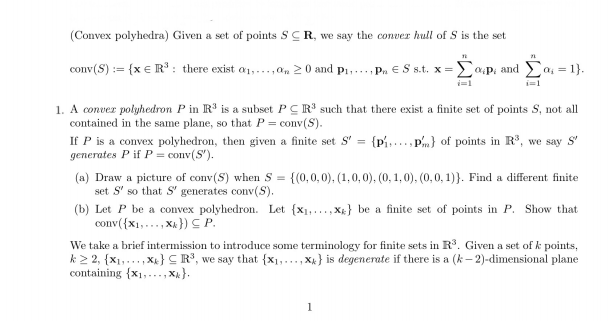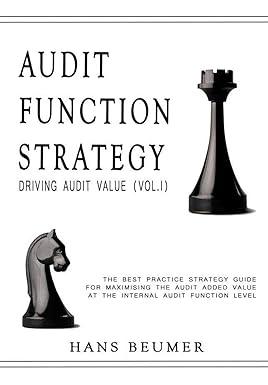

(Convex polyhedra) Given a set of points SCR, we say the conver hull of S is the set conv(S) := {x ER: there exist 01,..., On 0 and P... P ES s.t. x=> 1. A convex polyhedron P in R is a subset PCR such that there exist a finite set of points S, not all contained in the same plane, so that P = conv(S) If P is a convex polyhedron, then given a finite set s' = {p ...,P) of points in R, we say S' generates Pif P = conv(S'). (a) Draw a picture of conv(S) when S = {(0,0,0), (1.0.0), (0, 1.0),(0,0,1)). Find a different finite set s' so that S' generates conv(S). (b) Let P be a convex polyhedron. Let {x1,...,xx} be a finite set of points in P. Show that conv({X1,...,xx}) SP. We take a brief intermission to introduce some terminology for finite sets in R. Given a set of k points, k> 2, X1,...,xx} SR, we say that {x1,...,xx} is degenerate if there is a (k-2)-dimensional plane containing X1,...,x}. So, for example, a set of two points {X1, X2} is non-degenerate precisely when it is not contained in a single point, i.e. when X1 + X2; a set of three points {X1, X2, X3 } is non-degenerate precisely when it is not contained in a line; and a set of four points {x1,...,x4} is non-degenerate precisely when it is not contained in a plane. Note that every finite set in R with 5 or more points is degenerate. Whenever {x1,...,x*} is non-degenerate, we call conv({x1,...,xx}) a (k 1)-simpler. When k = 2 (or 3 or 4) a (k 1)-simplex is nothing more than a line segment (resp. a triangle if k = 3 or a tetrahedron if k = 4). When {x1, ..., xk) is non-degenerate (so in particular, k {2,3,4}), we write A({x1,...,xx}) = conv({x1,...,xx}) = {xR: there exist as .., on 20 with a = 1 st. x = ax;} for the corresponding (k-1)-simpler. We also write, for non-degenerate {x1,...,xx}, A({x1,...,xx}) := {x ERP: there exist 01,..., an> 0 with a; = 1 s.t. x= x;} for the interior of the (k-1)-simpler. Finally, we call ..,, ER with a: = 1 s.t. x=:x} for the (k 1)-dimensional plane containing {x1,...,xx}. (Convex polyhedra) Given a set of points SCR, we say the conver hull of S is the set conv(S) := {x ER: there exist 01,..., On 0 and P... P ES s.t. x=> 1. A convex polyhedron P in R is a subset PCR such that there exist a finite set of points S, not all contained in the same plane, so that P = conv(S) If P is a convex polyhedron, then given a finite set s' = {p ...,P) of points in R, we say S' generates Pif P = conv(S'). (a) Draw a picture of conv(S) when S = {(0,0,0), (1.0.0), (0, 1.0),(0,0,1)). Find a different finite set s' so that S' generates conv(S). (b) Let P be a convex polyhedron. Let {x1,...,xx} be a finite set of points in P. Show that conv({X1,...,xx}) SP. We take a brief intermission to introduce some terminology for finite sets in R. Given a set of k points, k> 2, X1,...,xx} SR, we say that {x1,...,xx} is degenerate if there is a (k-2)-dimensional plane containing X1,...,x}. So, for example, a set of two points {X1, X2} is non-degenerate precisely when it is not contained in a single point, i.e. when X1 + X2; a set of three points {X1, X2, X3 } is non-degenerate precisely when it is not contained in a line; and a set of four points {x1,...,x4} is non-degenerate precisely when it is not contained in a plane. Note that every finite set in R with 5 or more points is degenerate. Whenever {x1,...,x*} is non-degenerate, we call conv({x1,...,xx}) a (k 1)-simpler. When k = 2 (or 3 or 4) a (k 1)-simplex is nothing more than a line segment (resp. a triangle if k = 3 or a tetrahedron if k = 4). When {x1, ..., xk) is non-degenerate (so in particular, k {2,3,4}), we write A({x1,...,xx}) = conv({x1,...,xx}) = {xR: there exist as .., on 20 with a = 1 st. x = ax;} for the corresponding (k-1)-simpler. We also write, for non-degenerate {x1,...,xx}, A({x1,...,xx}) := {x ERP: there exist 01,..., an> 0 with a; = 1 s.t. x= x;} for the interior of the (k-1)-simpler. Finally, we call ..,, ER with a: = 1 s.t. x=:x} for the (k 1)-dimensional plane containing {x1,...,xx}








